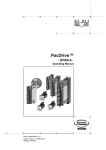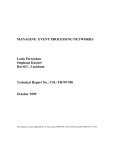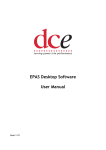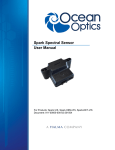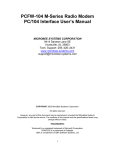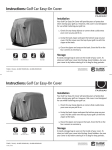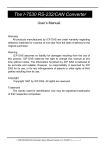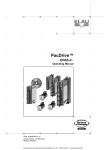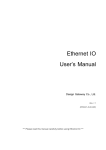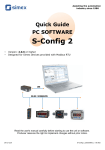Download EPAS Ultra Parameters
Transcript
EPAS Ultra Parameters Introduction This document provides additional information on the parameters used by the EPAS Ultra Electronic Power Assisted Steering Controller. These parameters allow some aspects of the operation of the controller to be adjusted for an individual application. Parameter adjustments are normally made using the EPAS Desktop Pro application. See the EPAS Desktop Pro User Manual or on-line help for more details on how parameters are viewed and altered. WARNING: Care must be observed when changing EPAS ECU parameters. Using the wrong values could damage both the EPAS ECU and the steering unit. Parameters Currently, the following four parameters are defined: Torque deadband Torque zero LH steering stop position RH steering stop position CAN message ID #1 CAN message ID #2 These will described in detail in the following sections. Torque Deadband The torque deadband, measured in bits, defines the amount that the steering torque sensor value needs to move from the zero value before any steering power assistance is delivered. The default value for the torque deadband is 4 bits. 1 EPAS Ultra Parameters Decreasing the torque deadband value can make the steering more responsive but can also lead to ‘hunting’ where the control unit constantly attempts to counteract a very small steering torque offset. Increasing the torque deadband value will make the steering less responsive but can compensate for a drifting or noisy torque sensor. Torque Zero The torque zero, measured in bits, defines the steady state torque reading where no steering torque is applied. All the steering torque sensors encountered so far have a zero of 128 ±10 bits. The default value for the torque zero is 128 bits. The torque zero parameter value is normally altered using the zeroing procedure built into the firmware of the unit which does not need a computer to be connected. In this procedure the power to the unit is switched on and then off (before the fault LED has gone out) three times in succession. The next time power is applied the fault LED will flash while the torque zero parameter is updated. It is important that, during this procedure, no steering torque is applied otherwise a false zero value will be set. If the torque zero parameter is incorrect then the steering will tend to be more responsive, or lighter, in one direction than the other. Steering Stop Settings A steering angle sensor can be used to limit the motor power when the steering reaches either end stop. This sensor must be fitted so that its output voltage is at its lowest point when the steering is against the lefthand steering stop and at its highest when the steering is against the righthand steering stop. When the steering reaches either end stop the motor power is progressively reduced over a 1.5 second period. LH Steering Stop Position The LH steering stop position, measured in bits, is the position of the lefthand steering stop as indicated by the steering angle sensor. Motor power reduction will occur when the measured steering angle is less 2 EPAS Ultra Parameters than the LH steering stop position setting. RH Steering Stop Position The RH steering stop position, measured in bits, is the position of the righthand steering stop as indicated by the steering angle sensor. Motor power reduction will occur when the measured steering angle is greater than the RH steering stop position setting. CAN Message IDs The EPAS Ultra ECU has a CAN interface through which instantaneous sensor values and operating status are transmitted. This information is grouped into two 8 byte messages each with their own ID. The CAN interface employs 11-bit message IDs so valid CAN message ID values lie in the range 0x001 to 0x7FF (1 to 2047). CAN Message ID #1 Sets the ID for the first CAN message. CAN Message ID #2 Sets the ID for second CAN message. 3



